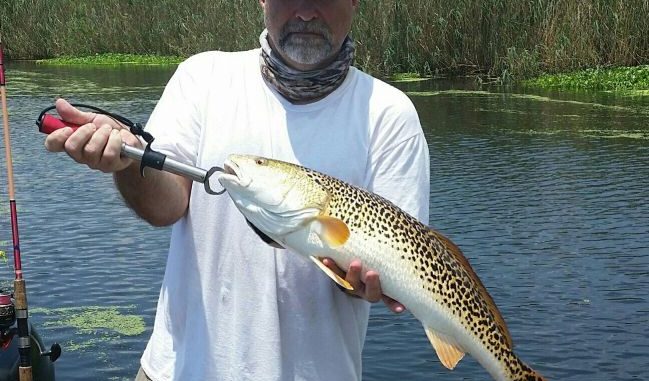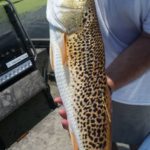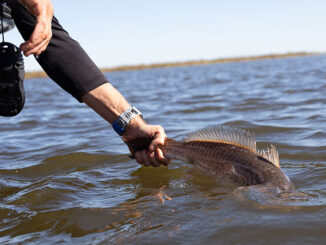
Rare fish likely the result of recessive pigmentation trait, geneticist says
Jerry Rouyea was definitely seeing spots on a recent fishing trip on the west side of the Mississippi River, but it wasn’t because of the stifling 93-degree heat and lack of any breeze that day out of Venice.
Rouyea, 52, of St. Amant, was fishing with his wife, daughter and his daughter’s boyfriend on the morning of Saturday, July 2, and they were in the process of loading up on some green trout — when a “leopard” made its presence known.
“The bass were on fire at the time,” he said. “We were fishing right up against the roseaus, and my daughter’s boyfriend had just caught a nice one, and I threw out. We were in some real, real clear water, and I could see the whole thing. I saw it charge the bait and hit it.”
What slammed into Rouyea’s Wob L Rite gold spoon turned out to be a 28-inch redfish that looked like it had a bad case of the measles — or perhaps was the result of a chance encounter between an amorous speckled trout and a willing red.
At final count, there were more than 300 spots on each side of the fish.
“I saw it as soon as it hit and I could tell it was spotted like that,” he said. “I was hollering, ‘It’s a leopard! It’s a leopard!’ And they were all looking at me like I was crazy.
“But when we netted it, they were finally able to see it, too. They couldn’t believe it — they were surprised.”
Dr. Kyle Piller, a fish geneticist at Southeastern University in Hammond who reviewed Rouyea’s pictures, said the redfish’s unique spots were likely the result of its parents both having a recessive pigmentation trait.
It’s definitely not a speckled trout-redfish hybrid, Piller said.
“People might look at this and initially think that’s a hybrid between a speckled trout and a redfish,” he said. “Even though they’re both closely related members of the drum family, they’re really quite distant within that family. And they’re members of different genera. Hybridization between two different species in two different genera does happen, but it’s very uncommon. This is essentially a variant or mutant based on the expression of a recessive gene from the parents…
“Whatever gene is involved in producing pigment, clearly in the recessive form it overproduces it.”
Piller classified a redfish with that many spots as “extremely rare,” and said he had read online about one redfish caught near the Florida Everglades in 1996 that had more than 500 spots. He hinted that just like other animals in nature that are born without traditional coloring and camouflage, anglers might rarely encounter them because so few actually survive.
“There’s natural variation in the number of spots redfish have. Most have one, some have a few, some have none — that’s really rare,” Piller said. “But this is essentially a variant or mutant based on the expression of a recessive gene from the parents.
“You don’t see this happen very often because perhaps this makes them more vulnerable to predators when they’re in the juvenile state. Who knows?”
Rouyea, who participates in the TAG Louisiana program, made a valiant attempt to release the red to fight another day, but the battle combined with the day’s warm temperature ultimately proved too much for the fish.
“We were trying to hurry up. We took as many pictures as we could quickly, and I tagged it and released it,” Rouyea said. “And we actually fished for about 5 minutes more, and we saw it under the water belly-up and going down to the bottom. So we got it back up and I worked on it for like 30 minutes trying to revive it, but he just did not make it.”
The group finished up the day with 29 bass and a handful of reds. Rouyea still has the unique fish in his freezer, and plans on using the photos to get a replica mount made that he’ll display at his home.
He recently enlarged pictures of the red, and counted an incredible 660 spots.
“I’ve seen a bunch of redfish — we’ve been fishing down there for years and years — and I’ve seen multiple spots,” Rouyea said. “But never anything close to that.”




